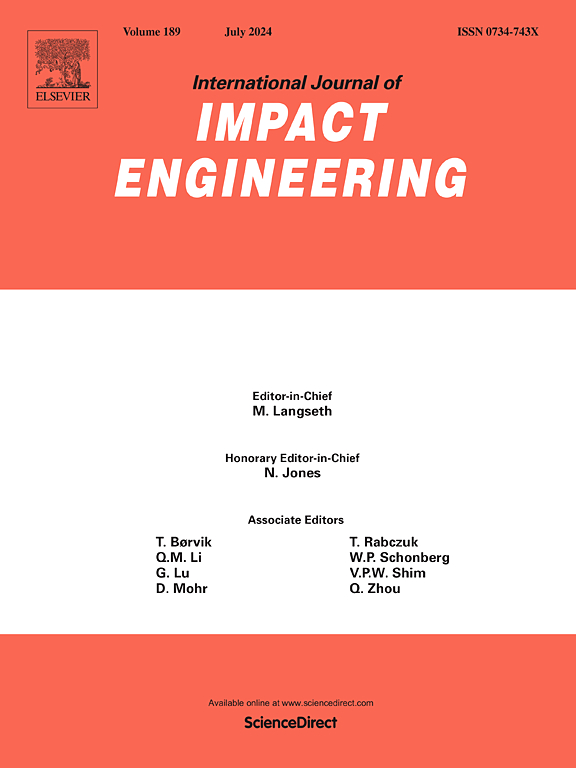Low-velocity penetration behavior of ice by slender steel projectiles with different noses
IF 5.1
2区 工程技术
Q1 ENGINEERING, MECHANICAL
International Journal of Impact Engineering
Pub Date : 2025-06-10
DOI:10.1016/j.ijimpeng.2025.105438
引用次数: 0
Abstract
The penetration behavior of ice has attracted great attention in recent years. In this paper, the penetration behavior of semi-infinite polycrystalline ice by slender projectiles with different ogival noses under impact velocities ranging from 39.5 to 88.5 m/s is studied by experiments and continuum-discontinuum element method (CDEM) simulations. Both the experimental and simulation results showed that with increasing impact velocity, the ice damage transforms from a crater mode to a crater-tunnel mode, and both the penetration depth and crater diameter increase accordingly. The critical velocity for the damage mode transition decreases and the penetration depth increases with increasing the sharpness of projectile nose. However, the crater diameter barely changes with the projectile nose. The maximum deceleration of projectile decreases as the projectile nose sharpens or the impact velocity decreases. In addition, the dynamic cavity expansion model is applied to calculate the penetrating resistance of projectile during tunnel stage. The discrepancy between the theoretical and simulated maximum deceleration is less than 13%, demonstrating the applicability of cavity expansion model for describing penetration behavior of ice under the present impact velocity range. This paper reveals the failure behavior of ice under various impact conditions and advances the understanding of penetration behavior of ice in engineering applications.
不同弹头细长钢弹对冰的低速侵彻行为
近年来,冰的穿透行为引起了人们的广泛关注。本文通过实验和连续-非连续单元法(CDEM)模拟,研究了在39.5 ~ 88.5 m/s的冲击速度范围内,不同射径的细长弹丸对半无限多晶冰的侵彻行为。实验和仿真结果均表明,随着冲击速度的增加,冰损伤由弹坑模式转变为弹坑-隧道模式,侵彻深度和弹坑直径均相应增大。随着弹鼻锐度的增大,破型过渡临界速度减小,侵彻深度增大。然而,弹坑直径几乎不随弹头变化。弹丸的最大减速度随着弹鼻变尖或冲击速度的减小而减小。此外,还应用动态空腔扩张模型计算了隧洞阶段弹丸的侵彻阻力。理论最大减速度与模拟最大减速度的差异小于13%,证明了空腔扩张模型在当前冲击速度范围内描述冰的侵彻行为的适用性。揭示了冰在各种冲击条件下的破坏行为,促进了对冰在工程应用中的侵彻行为的认识。
本文章由计算机程序翻译,如有差异,请以英文原文为准。
求助全文
约1分钟内获得全文
求助全文
来源期刊

International Journal of Impact Engineering
工程技术-工程:机械
CiteScore
8.70
自引率
13.70%
发文量
241
审稿时长
52 days
期刊介绍:
The International Journal of Impact Engineering, established in 1983 publishes original research findings related to the response of structures, components and materials subjected to impact, blast and high-rate loading. Areas relevant to the journal encompass the following general topics and those associated with them:
-Behaviour and failure of structures and materials under impact and blast loading
-Systems for protection and absorption of impact and blast loading
-Terminal ballistics
-Dynamic behaviour and failure of materials including plasticity and fracture
-Stress waves
-Structural crashworthiness
-High-rate mechanical and forming processes
-Impact, blast and high-rate loading/measurement techniques and their applications
 求助内容:
求助内容: 应助结果提醒方式:
应助结果提醒方式:


